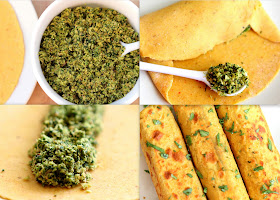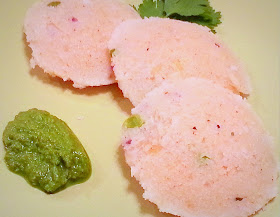The latest choice of weekend activity among our friends has been gathering at someone's house and cooking together. Oh, the joy of communal cooking and sharing meals! It's so much better than going out - the food is fresh and much healthier (not to mention, cheaper!), we get to learn each other's culinary skills, cooking doesn't feel like a chore when you want to relax, and most importantly, it gives us opportunity to have conversations and spend more quality time with each other.
Some interesting recipes always come out of our cooking rituals. Last night when we had gathered at our place, my friend Deepti taught me what I can claim as the yummiest eggplant dish I've had. A very unique and ridiculously easy recipe that'll make the pickiest eater love eggplants! It wasn't hard for me to fall in love since I like eggplants in any form, but my other friends who don't care for them couldn't stop eating it either. This was Deepti's grandma's recipe who had learned it from her Sindhi neighbors. Her grandma made it for them as an after-school snack. The preparation is very simple - cut aubergine eggplants in the center and make grid-like slits, sprinkle some masala on top and roast for a few minutes. Done.You just scoop out the center with a spoon and enjoy the crusty-spicy eggplant that is extremely delicate and juicy inside. Amazing how something as simple as that can turn an ordinary eggplant into a gourmet dish.
| If only you could taste this through the screen - don't be fooled by the color. |
Eggplant Bhajja
Ingredients:
4 Aubergine eggplants
1 1/2 Teaspoons cumin-coriander powder
1 1/2 Teaspoons garam masala/goda masala
3/4-1 Teaspoon red chili powder (depending on how spicy you want it)
Salt to taste
Oil as needed.
- Cut eggplants in the center lengthwise. Make vertical and horizontal grid-like slits as shown in the picture below. This way, the spice mix you sprinkle will get all the way through.
- Combine the spices and salt and sprinkle over the eggplants and in between the slits. You can adjust the level of spices according to your liking. My friend uses garam masala for this recipe but I prefer goda masala for the slight sweetness coconut adds.
- Microwave the eggplants keeping face up for 2-3 minutes. This speeds up the cooking process. The eggplants should feel soft to touch. The cooking time may vary depending on the eggplants size.
- Heat a pan on medium-high, drizzle a little bit of oil (very little - you are not shallow frying them) and keep the eggplants face down (the side of spices touching the pan). Cover the pan and let the eggplants roast for 2-3 minutes. Once they are slightly charred on that side, turn them, cover and cook for a couple of minutes more.



